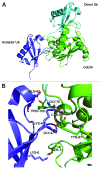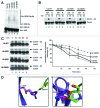Molecular and structural insight into lysine selection on substrate and ubiquitin lysine 48 by the ubiquitin-conjugating enzyme Cdc34
- PMID: 23656784
- PMCID: PMC3713132
- DOI: 10.4161/cc.24818
Molecular and structural insight into lysine selection on substrate and ubiquitin lysine 48 by the ubiquitin-conjugating enzyme Cdc34
Abstract
The attachment of ubiquitin (Ub) to lysines on substrates or itself by ubiquitin-conjugating (E2) and ubiquitin ligase (E3) enzymes results in protein ubiquitination. Lysine selection is important for generating diverse substrate-Ub structures and targeting proteins to different fates; however, the mechanisms of lysine selection are not clearly understood. The positioning of lysine(s) toward the E2/E3 active site and residues proximal to lysines are critical in their selection. We investigated determinants of lysine specificity of the ubiquitin-conjugating enzyme Cdc34, toward substrate and Ub lysines. Evaluation of the relative importance of different residues positioned -2, -1, +1 and +2 toward ubiquitination of its substrate, Sic1, on lysine 50 showed that charged residues in the -1 and -2 positions negatively impact on ubiquitination. Modeling suggests that charged residues at these positions alter the native salt-bridge interactions in Ub and Cdc34, resulting in misplacement of Sic1 lysine 50 in the Cdc34 catalytic cleft. During polyubiquitination, Cdc34 showed a strong preference for Ub lysine 48 (K48), with lower activity towards lysine 11 (K11) and lysine 63 (K63). Mutating the -2, -1, +1 and +2 sites surrounding K11 and K63 to mimic those surrounding K48 did not improve their ubiquitination, indicating that further determinants are important for Ub K48 specificity. Modeling the ternary structure of acceptor Ub with the Cdc34~Ub complex as well as in vitro ubiquitination assays unveiled the importance of K6 and Q62 of acceptor Ub for Ub K48 polyubiquitination. These findings provide molecular and structural insight into substrate lysine and Ub K48 specificity by Cdc34.
Keywords: Cdc34; SCF; Sic1; cell cycle; lysine; ubiquitin.
Figures






Similar articles
-
Molecular basis for lysine specificity in the yeast ubiquitin-conjugating enzyme Cdc34.Mol Cell Biol. 2010 May;30(10):2316-29. doi: 10.1128/MCB.01094-09. Epub 2010 Mar 1. Mol Cell Biol. 2010. PMID: 20194622 Free PMC article.
-
Release of ubiquitin-charged Cdc34-S - Ub from the RING domain is essential for ubiquitination of the SCF(Cdc4)-bound substrate Sic1.Cell. 2003 Sep 5;114(5):611-22. doi: 10.1016/s0092-8674(03)00641-x. Cell. 2003. PMID: 13678584
-
Pivotal role for the ubiquitin Y59-E51 loop in lysine 48 polyubiquitination.Proc Natl Acad Sci U S A. 2014 Jun 10;111(23):8434-9. doi: 10.1073/pnas.1407849111. Epub 2014 May 27. Proc Natl Acad Sci U S A. 2014. PMID: 24912152 Free PMC article.
-
The Ubiquitin Code in Disease Pathogenesis and Progression: Composition, Characteristics and its Potential as a Therapeutic Target.Discov Med. 2025 Feb;37(193):203-221. doi: 10.24976/Discov.Med.202537193.18. Discov Med. 2025. PMID: 39973547 Review.
-
Protein monoubiquitination and polyubiquitination generate structural diversity to control distinct biological processes.IUBMB Life. 2012 Feb;64(2):136-42. doi: 10.1002/iub.589. Epub 2011 Nov 30. IUBMB Life. 2012. PMID: 22131221 Review.
Cited by
-
Site-specific resolution of anionic residues in proteins using solid-state NMR spectroscopy.J Biomol NMR. 2020 Jul;74(6-7):355-363. doi: 10.1007/s10858-020-00323-z. Epub 2020 Jun 8. J Biomol NMR. 2020. PMID: 32514875 Free PMC article.
-
Structural insights into E1 recognition and the ubiquitin-conjugating activity of the E2 enzyme Cdc34.Nat Commun. 2019 Jul 24;10(1):3296. doi: 10.1038/s41467-019-11061-8. Nat Commun. 2019. PMID: 31341161 Free PMC article.
-
Ubiquitin-conjugating enzyme UBE2J1 negatively modulates interferon pathway and promotes RNA virus infection.Virol J. 2018 Aug 29;15(1):132. doi: 10.1186/s12985-018-1040-5. Virol J. 2018. PMID: 30157886 Free PMC article.
-
Lysine-63-linked polyubiquitination: a principal target of cadmium carcinogenesis.Toxicol Res. 2024 Apr 21;40(3):349-360. doi: 10.1007/s43188-024-00236-1. eCollection 2024 Jul. Toxicol Res. 2024. PMID: 38911543 Free PMC article. Review.
-
PHOTOTROPIN1 lysine 526 functions to enhance phototropism in Arabidopsis.Planta. 2024 Feb 2;259(3):56. doi: 10.1007/s00425-024-04332-2. Planta. 2024. PMID: 38305934
References
Publication types
MeSH terms
Substances
LinkOut - more resources
Full Text Sources
Other Literature Sources
Molecular Biology Databases
Research Materials
